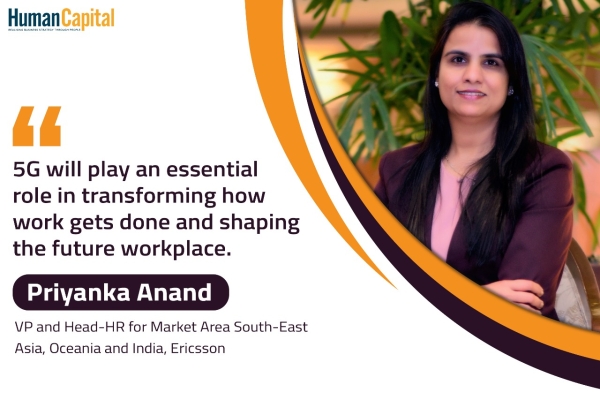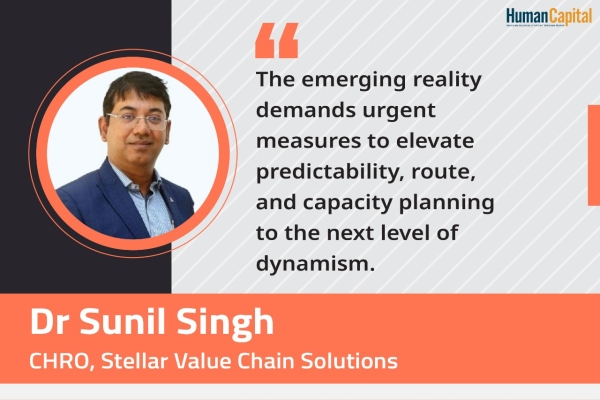5G technologies will enable the growing percentage of employees to work from home as well as experience smoother and more reliable connections to keep operations running full steam ahead
Since the COVID-19 pandemic first struck, companies around the world have had to dramatically change the way business is conducted, including how their employees continue to work. Today, as the world slowly recovers from the pandemic and returns to some semblance of normalcy, an often-asked question or, rather, a most-discussed topic is: What will be the future of work? This becomes even more pronounced with countries across the world deploying 5G and India standing at the cusp of making 5G a reality in the country.
Why 5G? With its faster connectivity speeds, low latency, better security and greater bandwidth, 5G will play an essential role in transforming how work gets done and shaping the future workplace.
The pandemic has challenged some long-held beliefs about ways of working and has accelerated the rate of change towards digitalisation and flexibility in the workplace. This has brought to the fore the critical role of connectivity as never before, where networks have allowed people to stay connected at work and home. In many ways, we have leapfrogged into a new way of working that is more flexible and that meets both business and individual needs.
5G Technologies
5G technologies will enable the growing percentage of employees to work from home as well as experience smoother and more reliable connections to keep operations running full steam ahead. Not only that, 5G will dramatically improve remote collaboration for a ‘work-from-anywhere’ principle and enable more creativity, productivity, and engagement among the workforce.
Imagine a scenario where we can maintain the physical atmosphere of an office without having to leave home. Extended reality-enabled interactions over 5G would have a minimal delay between real and virtual world actions, letting us feel like we’re almost there in person. According to Ericsson’s report, ‘The dematerialised office: A vision of the internet of senses in the 2030 future workplace’, half of about 8,000 white-collar respondents said they would prefer a digital workstation to enable their full-sense presence while working from anywhere.
Embracing virtual collaboration in the changed, new reality and the entire experience of navigating through the crisis has given us the opportunity and ability to embrace 5G in a big way.
I also believe that in the future, this ‘new normal’, where employees can work from anywhere, at almost any time that suits them and with anyone, will eventually become ‘the normal’. It will also underscore the way ‘talent’ will evolve in the future. For a “working anytime, anywhere and with anyone” workforce, 5G will bring a huge significance of highspeed connectivity.
Moreover, with accelerated digitalisation across industries, the skills and expectations from employees will also change. Thus, the workforce will have to be more adaptable and agile, be ready and self-motivated to update their skillsets constantly and be nimble enough to address rapidly changing situations.
Some Other Trends to Watch Out for in 2022 and Beyond
We are seeing the emergence of diverse employment models. So far, we have witnessed a static approach towards full-time jobs, and that’s how organisations have defined their talent strategy. However, now there is a significant shift towards the gig economy, hybrid workplaces, and flexible employment patterns.
Organisations will need to re-imagine the future workplace in their own unique way to cater to greater flexibility and new ways of working. For instance, when it comes to the ‘physical workplace’, offices will need to be designed based on different needs and preferences of employees instead of roles and functions. It will be a place where people come together to create, collaborate, and socialise. The ‘virtual workplace’ should enable a seamless collaboration experience both in and outside the office by leveraging new and optimised tools and applications. From a people and culture standpoint, steps must be taken to ensure work-life balance for the workforce through greater flexibility as well as creating empowering leadership.
Conclusion
There is no doubt that we won’t be coming back to the same work environment. The world has changed, and our workplace must change with it. The future of work will be hybrid, and technology will be a game-changer and enabler across all facets of an organisation. HR processes are getting further automated to improve employee experience and productivity. Technologies such as AI/ML, blockchain, IoT, and big data analytics, will continue to be introduced in HR processes.
To conclude, the future will continue to bring rapid changes, and leaders and employees must be well-equipped to deal with them. There is no substitute for collaboration and two-way communication — manager to manager, peer to peer, human to human, and limitless connectivity will make this collaboration a reality in ways that are unimaginable yet possible!
Is your organisation post-COVID-ready?
Trending
-
SBI General Insurance Launches Digital Health Campaign
-
CredR Rolls Out 'Life Happens' Leave For Its Employees
-
Meesho Announces 30-Week Gender-Neutral Parental Leave Policy
-
Microsoft Unveils Tech Resilience Curriculum To Foster An Inclusive Future
-
60% Indian Professionals Looking For Job Change Due To COVID: Survey
-
SpringPeople And Siemens Collaborate For Digital Transformation Push
-
86% Professionals Believe Hybrid Work Is Essential For Work Life Balance: Report
-
Almost 1 In Every 3 People's Personal Life Affected Due To Work Stress
-
Meesho Rolls Out Reset And Recharge Policy For Employees
-
80% Of Talent Leaders & Academics Say Pandemic Changed Skill Needs For Youth: Report
-
Hero Electric Rolls Out 'Hero Care' Program For Employees
-
Human Capital In Collaboration With ASSOCHAM Hosts Virtual Conference
-
IKEA India, Tata STRIVE Collaborate To Create Employability And Entrepreneurship Opportunities
-
SAP India, Microsoft Launch Tech Skilling Program for Young Women
-
DXC Technology, NASSCOM Collaborate For Employability Skills Program
-
Lenskart To Hire Over 2000 Employees Across India By 2022
-
Mindtree Launches Learn-and-Earn Program
-
Tata AIA Extends 'Raksha Ka Teeka' To Its Employees
-
Swadesh Behera Is The New CPO Of Titan
-
NetConnect Global Plans To Recruit 5000 Tech Professionals In India
-
Hubhopper Plans To Hire 60% Of Indian Podcasters By 2022
-
Corporate India Needs More Women In Leadership Roles: Report
-
Aon to Invest $30 Million and Create 10,000 Apprenticeships by 2030
-
Tech Mahindra Launches ‘Gift a Career’ Initiative for Upskilling of Youth
-
40% Women Prefer Flexible Working Options in Post-COVID World: Survey
-
3 out of 4 companies believe they can effectively hire employees virtually: Report
-
Vodafone , CGI and NASSCOM Foundation launch digital skills platform
-
Odisha: Bank, postal employees to deliver cash for elderly, differently-abled persons
-
Skill India launches AI-based digital platform for "Skilled Workforce"
-
Hiring activity declines 6.73% in first quarter: Survey
-
70% startups impacted by COVID-19 pandemic
-
Bajaj Allianz Life ropes in Santanu Banerjee as CHRO
-
Over 70 Percent MSMEs look at cutting jobs to sustain businesses
-
93 Per Cent employees stressed about returning to office post-lockdown
-
Johnson & Johnson India announces family benefits for same gender partners
-
Indian firms turning friendly towards working mothers
-
Welspun India names Rajendra Mehta as new CHRO
-
Wipro partners with NASSCOM to launch Future Skills platform



Human Capital is niche media organisation for HR and Corporate. Our aim is to create an outstanding user experience for all our clients, readers, employers and employees through inspiring, industry-leading content pieces in the form of case studies, analysis, expert reports, authored articles and blogs. We cover topics such as talent acquisition, learning and development, diversity and inclusion, leadership, compensation, recruitment and many more.
Subscribe Now












































Comment